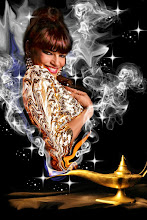
The history and use of balanced props in Oriental Dance is as subject to speculation as the dance form itself, but it seems that for decades- if not centuries- belly dance performers have often used balanced props to display their grace and skill. Though this is by no means at all a complete history on the use of balanced props, perhaps it will help you, dear reader, to understand why we-belly dancers-use some of these gorgeous "dance partners" on stage.
The origins of sword dancing are unclear; and many people believe it came from American Cabaret belly dance, and was never traditional in Middle Eastern folkloric dances performed by females, let alone as a part of raqs sharqi. Used as a display of weaponry or prowess, swords, scimitars and daggers have been used often in dances or displays ( by men) in the Gulf regions, as well as in The Levant.
However, the roots of sword or scimitar dancing as performed by women do seem to come from North Africa or Turkey. There are many 19th century Orientalist paintings and lithographs depicting scenes with musicians playing as jewel-bedecked women dance with curved scimitars atop their heads, and there are also numerous written references to dancers performing with sabres stemming from the same time period. It is difficult to tell if this was merely an Orientalist fantasy, or a recording of actual events as seen by Western travellers.
Exotic and glamorously dangerous, sword dancing is extremely popular today in cabaret and fusion style performances. The curved scimitars are balanced on the head, chest, shoulders, wrists- as well as many other locations-on the body of the dancer, and many dancers use more than one sword.
The contemporary version of sword dancing ( dating from the late 1960's into the '70's) has been attributed both to noted dancers Leona Wood (who used a custom made carved wooden sword) as her prop, and to Jamila Salimpour, whose troupe Bal Anat was a precursor to the American Tribal style of belly dance.
Raks shamadan, performed by a dancer crowned with large, flaming candelabra, is an Egyptian wedding tradition, dating from the turn of the last century, in the time before electricity. Shamadan-bearing dancers lead the zeffah al-arousa or bridal procession through the darkened streets, illuminating the newly married couple, a tradition that is still continued today. Because of its spectacular effect, the dance was also performed theatrically, as part of both cabaret and folkloric Oriental performances.
Some believe that in the 1920’s, Badia Masabni brought the dance to the stage of her Cairo nightclub, The Casino Opera, where legendary Golden Age dancers like Tahia Carioca and Samia Gamal began their careers. But a more likely version of the origin is credited to a pair of Egyptian dancers from the Mohammad Ali Street district of Cairo, at the turn of the last century. It is believed that Egyptian dancer Zouba El Klobatiyya was the first performer to dance with a lantern-or klob- balanced on her head- hence, her name. If she wasn’t actually the first dancer to perform with a lantern balanced atop her head, she did at least become the first to gain recognition for it. She was followed in quick succession by a Coptic Christian dancer, Shafiya El Koptyyia (Shafiya The Copt) who also performed this skill.
Much more recently, Egyptian dancer Nadia Hamdi, who is known the world over for her shamadan skills and floor work including splits, is noted for her skills with shamadan, having been trained by the original dancers, and is still in action today, preserving the tradition.
Other folkloric dances from Egypt that sometimes incorporate balancing skills include balass (water jug) dance, where the vessel is held on the shoulder and sometimes balanced on the head of the dancer, and raks assaya, where the performer manipulates a cane, twirls it, and if skilled, balances the cane on various parts of the body. Tunisian and Moroccan folkloric dancers balance clay pots (or stacks of them!) on the head, as well as doing head balances with large brass trays, sometimes laden teapots, glasses. Both male and female performers perform tray dancing, and the illustrious John Compton is one of the masters of this dance.
Please be aware that working with any type of balanced prop can take years to perfect. It requires absolute stability of the head and neck, and increased flexibility and power (especially in the upper thighs, abdomen and arms) for floor work. The heightened isolation skills, mental concentration and slower movements necessary for balance will have a very positive affect on your overall dancing. You will need to practice- a lot. You also must be sure that in addition to your regular warm-up, to really thoroughly warm up your neck, shoulders, upper arms and thighs before attempting to balance anything…even if you are already comfortable with performing floor work, and the extra weight on your head.
Above all, please remember when balancing any sort of props, whether used with or without fire: SAFETY FIRST!











No comments:
Post a Comment